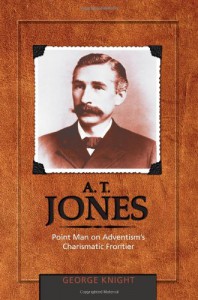Currently reading
A.T. Jones: Point Man on Adventism's Charismatic Frontier

One of the pivotal figures during the 1888 Minneapolis General Conference session on the debate about the Adventist view of righteousness by faith, he become one of the most influential leaders of the church for a decade before his extreme leanings lead him into apostasy. George R. Knight’s A.T. Jones: Point Man on Adventism’s Charismatic Frontier follows the life and career of one of Adventism’s most important figures for both good and ill as well as how he went from almost being General Conference President to be disfellowship in less than a decade.
Bringing decades worth of research and materials, Knight essentially begins his biography on Jones with his conversion to Seventh-day Adventism and the beginning of his ministerial career months later. He talent and ability got him noticed by the Whites and other denomination leaders allowing him to go to California to begin teaching at and editing denomination periodicals, including those focused on religious liberty. While in California, Jones met and studied with E.J. Waggoner forming a partnership that would last the rest of their lives during which they would oppose “the establishment” in the denomination beginning in the lead up to Minneapolis in 1888 and continuing even as they got General Conference leadership positions. After following the ramifications of the Minneapolis, Knight continued chronicling Jones’ life and career including his need to go to the extreme in his logic, arguments, and beliefs which would eventually lead to his battle against the denomination’s organizational structure that would force him against A.G. Daniells and joining the side of John Harvey Kellogg that would see both disfellowshipped from the church.
Given Jones controversial place in Adventist history, Knight was clear on which positions and theological developments that Jones championed are still with Adventists and which were too extreme officially but still have an influential strain even today. A part of this divide is how Ellen G. White reacted and corresponded with Jones on his thoughts and beliefs as well as the relationship between the two over the course of two decades. Unlike his colleague Waggoner, Jones’ family life was unfortunately not covered much but as Knight pointed out he late in his biography it was because he was never home to be a real father and husband or lived in the same state as his family during important periods in his life.
A.T. Jones gives a detailed view into the life, teachings, and career of one of the most important individuals in Adventism at the turn of the century. George R. Knight covers the ups and downs of Jones’ life as well as explaining his positions and how he developed them, but in a very readable and understandable way for lay readers without getting too technical. A highly recommended book for those interested in Adventist history.





